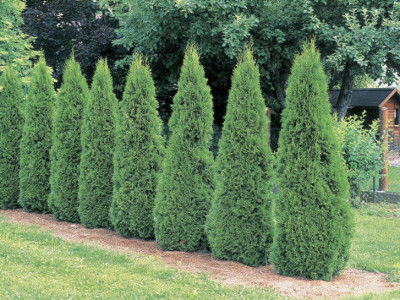American Arborviate Tree (Thuja occidentalis)
Category: Evergreen Trees

The American Arborvitae belongs to the Thuja occidentalis family. It is a conifer evergreen species that is commonly used as a privacy tree or an accent tree. It is also preferred as windbreaker.
Description
The American Arborvitae is a narrow pyramid shaped tree which makes it a natural choice to act as windbreakers. It is a tall and with an elegant appearance. A single tree can grow to a height of 40’ - 60’ feet tall and with a spread of 15’ feet while in the wild but can reach 20’ – 30’ feet in height and a spread of 12’ while in the urban surrounding.
In summer it has bright green foliage which changes to yellow-brown-green during the winter season.
The American Arborvitae blooms in the spring with purplish-brown flower. It also has fruits which are cone-like and are about an inch long and with 8 to 10 scales. The seed is about 1/8 inch long.
The American Arborvitae has a gray shredding bark.
Attributes
The American Arborvitae prefers moist soil and might not withstand extended periods of drought. They will benefit under shade when still young partial sun will also be okay to the tree but they are very susceptible to the sporadic winter burn.
Pests
The spider mites can buildup during the hot dry seasons, and occasionally the bagworms can also be seen. Extract of the tree is somehow toxic to specific insect pests.
The American Arborvitae specie is a good tree for cover and will attract birds as it is preferred for nesting and also as food.
Benefits
The American Arborvitae makes good fence posts, cups, bowls, furniture and boxes. It also used for medicinal purposes. For years decoction has been used to treat or suppress rheumatism, intermittent fevers, toothaches, scurvy, coughs, and dropsy. It is also a source for making antibiotics.
Other common names include the White Cedar and Eastern Arborvitae.

 Back To Category Evergreen Trees
Back To Category Evergreen Trees